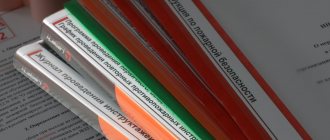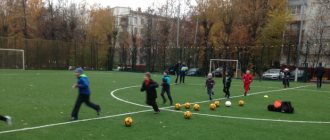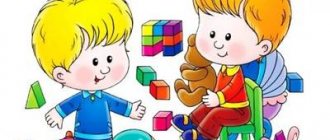Long-term work plan for the regional component in kindergarten. Senior group
Long-term work plan in the senior group of the MKDOU DS "Solnyshko" in the village of Golubinka, Republic of CRIMEA for the use of the national-regional component
Month Topic Contents of work Note
September We continue to get acquainted with our immediate environment. -Walks and excursions along the streets of your native village. -Creation of a model “The street on which our kindergarten is located.” -Meetings with interesting people who worked in our kindergarten. -Exhibition of photographs “My Village” -Excursions around the village. October “My little Motherland” - My village Golubinka (location on the map of the region, on the globe). -City streets, our attractions. -The house I live in. Exhibition of drawings “My Street” Watching the video “Belbek Valley” November “I live in Crimea” - Location of Crimea on the map, globe. — Watching the video “Crimea.” -Why is our region called Crimea sunny, warm, affectionate? -Examination of sets of postcards “Cities of the Republic of Crimea”. December “The beauty and richness of Crimean nature” - Features of Crimean nature and wildlife. -Acquaintance with the nature of the CRIMEA. -Fauna of Crimea, watching a video. -Looking at photo albums about the nature of your native land. January Crimean writers Polyakov Y. Kozeeva I. -Acquaintance with the works of writers. -Reading excerpts from the Tale of the Ancient Forest by E. Belousov and How a Man Found Health in the Crimea, learning the poems The Black Sea, Our Crimea. -Exhibition and reading of poems and fairy tales by Crimean writers and poets.. -Exhibition of drawings based on fairy tales and stories. February “The wealth of the Crimean land” - Minerals of the Republic of Crimea. -Healing properties of water. -Where and how are minerals used? — Experiences and experiments on the topic. March “Grandma’s Chest” - Introducing children to women’s Ukrainian and Crimean Tatar national costume. — “It’s warm in the sun, and kindness in the presence of a mother” -Exhibition of drawings “Russian sundress” Ukrainian scarf. Crimean Tatar pattern. -Learning proverbs about mother. April “As it is at home, so it is yourself” - Russian hut - Ukrainian hut. — Everyday and festive home decoration. - Brownie - who is he? — We draw a Russian hut and a Ukrainian hut. The plan is based on the collections: Methodological manual for the implementation of the regional program for intercultural education of preschool children in Crimea “Crimean Wreath” “From the experience of preschool teachers in developing preschoolers’ interest in the history of our Motherland, the life and work of people, nurturing love and a creative attitude to the nature of the native land" The lesson is held once a month, as a lesson in the cognitive cycle.
Download the long-term work plan for the regional component in kindergarten. Senior group
We recommend watching:
Objectives of the upbringing and education of children for the 3rd quarter in the senior group Program for landscaping and landscaping in kindergarten Thematic planning for the spiritual and moral education of children in the senior group
Similar articles:
Comprehensive thematic planning for artistic and aesthetic development in the senior group
Comprehensive thematic planning for cognitive and speech development in the senior group
Card index of didactic environmental games (regional component)
Municipal budgetary preschool educational institution kindergarten "Romashka" Lyantor
“Card index of didactic environmental games”
(regional component)
Completed by: Kochelaeva Elena Evgenievna
Card#1
Ball game "Air, earth, water."
Target:
consolidate children's knowledge about natural objects. Develop auditory attention, thinking, and intelligence.
Materials:
ball.
Progress of the game:
Option #1
. The teacher throws the ball to the child and names an object of nature, for example, “magpie.” The child must answer “air” and throw the ball back. To the word “dolphin” the child responds “water”, to the word “wolf” - “earth”, etc.
Option #2.
The teacher calls the word “air”; the child who catches the ball must name the bird. For the word “earth” - an animal that lives on earth; to the word “water” - the inhabitant of rivers, seas, lakes and oceans.
Card
No. 2
Ball game “Living inanimate nature”
Target:
consolidate children's knowledge about objects of living and inanimate nature
Materials:
ball, slides
Progress of the game:
Option #1.
The teacher throws the ball to the child and names the object, if the object is living nature, the child catches the ball, if the non-living object hits with two palms. For example, a “mushroom” child catches a ball, a “stone” hits it.
Option #2.
The teacher, using an interactive board, invites children to look at images of nature. If the image relates to living nature, children should clap and stamp on inanimate things.
Option #3
The teacher, in individual work with children, invites children to sort cards with images of nature. In a house with a red roof put images of inanimate nature, with a green roof living nature.
Card
No. 3
Didactic game “Use the appropriate environmental sign”
Target:
continue to create a desire to protect the nature and wildlife of Ugra.
Materials
: module, cards with images of wildlife (insects, animals, plants), cards with images of environmental signs.
Progress of the game:
The teacher has a short conversation with the children about the rules of behavior in the forest. Gives children cards with images of environmental signs and asks them to place them on the module next to other images to which it relates.
Card
No. 4
Game “Web of Life”
Target
: teach children to create an ecological chain using several components of living nature.
Materials:
cards with images of living nature components, thread.
Progress of the game:
Option #1.
The teacher gives the children cards depicting environmental components (plants, animals, birds, insects). During the game, the teacher calls them, the children take turns, wind the thread around their wrist and take any convenient place in the circle, creating a web of life. At the end, the teacher talks about how, due to the cutting down of trees and fires caused by humans, the number of trees has sharply decreased, which has led to the extinction of some species of insects. Children let go of the thread and analyze why this happened and what needs to be done to avoid it.
Card#5
Didactic game “Choose the right one.”
Target:
consolidate knowledge about nature. Develop thinking and cognitive activity.
Materials:
subject pictures.
Progress of the game:
Object pictures are scattered on the table. The teacher names some property or sign, and the children must choose as many objects as possible that have this property. For example: “green” - these can be pictures of a leaf, cucumber, cabbage, grasshopper. Or: “wet” - water, dew, cloud, fog, frost, etc.
Card#6
Didactic game “Fold the animal.”
Target:
consolidate children's knowledge about wild animals living in Ugra.
Materials:
pictures depicting different animals (each in duplicate).
Progress of the game:
One copy of the pictures is whole, and the second is cut into four parts. Children look at whole pictures, then they must put together an image of an animal from the cut parts, but without a model.
Card#7
Didactic game “Who? Where? Lives"
Goal: to consolidate knowledge about the animals of Ugra and their habitats.
Material:
module, cards with images of wild animals living on the territory of Ugra, cards with images of their homes.
Progress of the game:
Children have pictures of animals, and on the module there are pictures of habitats (burrow, den, river, hollow, nest, etc.). The teacher makes a riddle about an animal, the child who guessed his animal places the picture on the module next to the habitat (a squirrel is a hollow, a bear is a den).
Regional component of the Stavropol Territory in the preparatory group
Alieva Elena
Regional component of the Stavropol Territory in the preparatory group
MUNICIPAL BUDGETARY PRESCHOOL EDUCATIONAL INSTITUTION
"KINDERGARTEN No. 12"
PREDGORNY DISTRICT
STAVROPOL REGION
Long-term work plan for the regional component in kindergarten . Preparatory group
Educator: Alieva E. D.
2017
Long-term work plan for the regional component in kindergarten . Preparatory group
Love for the native land, for the native culture,
to your native village or city, to your native speech
starts small: with love for your family,
to your home, to your school.
Gradually expanding, this love passes
in love for your country - for its history,
its past and present, and then to all humanity, to human culture.
D. S. Likhachev.
The holistic development of a child’s personality is the main meaning of preschool childhood. And you cannot educate without developing a feeling of love for your Motherland, your native land, your beloved city.
The purpose of this section of the program is to develop the cognitive interests of preschool children in mastering the cultural and historical values of our region and village , improving the culture of interethnic relations, and the formation of universal human values.
Each topic in this section is specified in each type of children's activity as follows:
My land is my homeland
(September October)
Sections of the program Types of children's activities
Educational activity 1. Conversation “Historical past
of the Stavropol region ” (history of settlement, life and way of life of the Cossacks)
.
Goal: to introduce children to the historical past of the region . Develop cognitive interest.
2. Design of the presentation “Symbols of the Stavropol Territory (coat of arms, anthem, flag)
».
Goal: to introduce children to the symbols of the region , to evoke a feeling of patriotism and love for their homeland.
3. Drawing “ Stavropol courtyard ”
.
Goal: to teach children to draw a farmstead and convey its characteristic features. Develop imagination.
4. Lesson “Ritual holidays in the Stavropol region ”
.
Goal: to introduce children to ritual holidays in the Stavropol region , to develop cognitive interest.
5. Design of the presentation “Various types of historical trades and crafts in the Stavropol region .”
Goal: to introduce children to various types of historical crafts and crafts in the region, to develop cognitive interest.
6. Looking at photos with views of Stavropol, the capital of the Stavropol Territory .
Goal: to introduce children to the capital of the region . Develop cognitive interest. Enrich your vocabulary.
7. Design of the presentation “Symbols of the city of Pyatigorsk.”
Goal: to introduce children to the symbols of the city of Pyatigorsk. Cultivate a love for the city.
8. Excursion along the ecological trail.
Goal: to develop love for your small homeland through observing the nature of your native land . Cultivate a sense of beauty, develop joyful emotions.
Fiction Reading poems and stories of Stavropol poets and writers ,
(A. E. Ekimtseva “The long grass has turned yellow.”
;
I. V. Kashpurova “Geese”
.)
Goal: to introduce children to the works of Stavropol authors . Cultivate a love for the artistic word.
Music 1. Listening to the anthem of the Stavropol Territory .
Goal: to continue to acquaint children with the symbols of Stavropol . Foster patriotism.
2. Listening to the Russian anthem.
Goal: to continue to acquaint children with the symbols of our Motherland.
Moral education Continue to develop interest in the “small homeland”
.
To cultivate love for your homeland through familiarity with the symbols, culture and way of life of Stavropol .
Educational activity: Acquaintance with the culture of the Cossacks.
November-December-January
1. Visit to the Cossack household room. Purpose: to introduce children to household items, kitchen utensils, and Cossack costume. Develop cognitive interest.
2. Looking at photos (Cossack national costume)
.
Goal: to continue to introduce children to the Cossack costume. Expand words knowledge.
3. Design of the presentation “Household items and kitchen utensils of the Cossacks”
.
Goal: to continue to acquaint children with household items and kitchen utensils of the Cossacks. Expand words knowledge.
4. Drawing “Cossack”
.
Goal: teach children to draw a boy in a Cossack costume. Cultivate love for your small homeland.
5. Modeling “Water carriers at the well”
.
Goal: to continue introducing children to the life of the Cossacks, developing cognitive interest and love for their small homeland. Develop fine motor skills.
6. Drawing “Wooden Spoon”
.
Goal: to continue acquainting children with Cossack kitchen utensils. To cultivate an aesthetic attitude towards everyday culture and objects of art.
7. View the presentation “Dishes of Cossack cuisine”
.
Goal: to introduce children to Cossack cuisine. Make children want to cook one of the dishes. Expand children's vocabulary.
fiction 1. Reading Stavropol folk tales , proverbs and sayings.
Goal: continue to introduce children to the folklore of Stavropol . Foster a desire to understand the culture of your people through fairy tales, proverbs and sayings.
2. Watching cartoons: “How the Cossacks bought salt”
,
“How the Cossacks became Olympians”
,
“How the Cossacks walked at a wedding”
, etc.
Goal: to continue to introduce children to the life of the Cossacks. Foster love for your homeland.
music 1. View slides “Cossack musical instruments”
(accordion, rattles, tambourine)
.
Goal: to introduce children to Cossack musical instruments. Expand children's vocabulary.
2. Listening to Cossack songs ( “I’ll go to the Cossacks”
,
“Cossacks”
by A. Popov,
“Bread is the head of everything”,
etc., songs performed by the Kuban Cossack choir, under the direction of V. Zakharchenko.
Goal: to continue to introduce children to Cossack songs. Foster a love for the culture of your people.
3. Watching video clips “Dancing Cossacks”
(
“Kuban poleka”
,
“Dance with balalaikas”
,
“Dance with handkerchiefs”
).
Goal: to continue to introduce children to Cossack dances. Make you want to learn one of the dances.
Culture of the peoples of Stavropol .
February March
Sections of the program Types of children's activities
gaming activity, health and physical development Outdoor games: “Flowers and breezes”
,
“The Shepherd”
,
“The Stealing of Fire”
,
“Tug of Stick”
,
“Fortress”
.
Goal: To instill in children a desire to learn the culture of the Armenian and Azerbaijani peoples through national games. Develop courage, endurance, courage.
educational activity 1. Examination of photos (national costumes of the people living in the Stavropol region ).
Goal: to introduce children to national costumes. Expand children's vocabulary.
2. Design of the album “Household Items and Kitchen Utensils.”
Goal: to introduce children to household items and kitchen utensils of the peoples
of the Stavropol region .
Expand words knowledge. 3. Excursion to the Cossack Museum.
Goal: to continue to introduce children to household items, kitchen utensils, and Cossack costumes. Develop cognitive activity.
4. Drawing “Ornament of the national costume”
.
Goal: to introduce children to the ornaments of Azerbaijani and Cossack national costumes. Create a desire to convey it in your drawings. Foster respect for the culture of other nations.
5. Modeling “Jug”
(clayware)
.
Goal: continue to introduce children to kitchen utensils. Arouse interest in sculpting one of the objects. Develop fine motor skills.
6. View the presentation “Dishes of Azerbaijani cuisine”
.Goal: to introduce children to Azerbaijani cuisine. Make children want to cook one of the dishes.
7. Drawing “Boy in Armenian costume”
.
Goal: to continue to introduce children to the Armenian national costume. Foster a respectful attitude towards the Armenian people.
fiction Reading Armenian and Azerbaijani folk tales: “How the king was fooled”
,
“The Tale of Azarap-Blbul”
,
“The Wise Weaver”
,
“The Death of Kikos”
,
“Little Goat”
,
“Rain”
,
“Two Brothers”
,
“Golden-haired Girl.”
Goal: to introduce children to folk tales. To cultivate a desire to understand the culture of the people living in our region through fairy tales, proverbs and sayings.
music 1. View slides “Azerbaijani folk instruments”
(kamancha, zurna, duduk)
.
Goal: to introduce children to Azerbaijani folk instruments. Expand children's vocabulary.
2. Listening to folk songs.
Goal: to introduce children to the folk songs of the peoples living in the Stavropol region . Make you want to learn one of the songs. Foster a caring attitude towards the culture of peoples.
2. Watching videos of “national dances”
.
Goal: to introduce children to the folk dances of the peoples of the Caucasus. Make you want to learn one of the dances.
moral education Continue to cultivate the desire to learn about the culture of peoples through fairy tales, songs, and dances. Foster a respectful attitude towards the culture of other peoples.
Getting to know the cities of the CMS
April May
Sections of the program: types of children's activities
gaming activity, health and physical development Outdoor games: “Burners.”
,
“Burn, burn clearly.”
Goal: To cultivate a desire to play folk games. Develop masculinity, endurance, agility.
educational activity 1 Looking at pictures about the sights of Pyatigorsk.
Purpose: To give a basic idea of this city . Develop cognitive activity.
3. Looking at a photo about a failure, a photo of an eagle, a photo of the Beauty Flower Garden of Pyatigorsk.
Goal: To instill love for the native land and its attractions.
4. Introduce Lermontov’s house in Pyatigorsk.
Purpose: To give a basic idea of the poet . introduce him to his poems.
5. Acquaintance with Essentuki and Kislovodsk.
Goal: To introduce the beauty of nature and architectural monuments.
6. Modeling “Eagle”
.
Goal: to introduce children to one of the symbols of Pyatigorsk. Arouse interest in sculpting an object. Develop fine motor skills.
7. View the presentation “Cities of the CMS”
.
Goal: to introduce resort cities.
8. Drawing “Pyatigorsk.”
Goal: continue to introduce children to the sights of the region
fiction Reading stories and fairy tales by writers from the CMS."
Goal: to continue to expand children’s understanding of their native land .
music 1. Listening to Russian folk songs of our time. Goal: To cultivate a love for folk songs.
2. Listening to songs of peoples living in the cities of the KMS.
Goal: To cultivate love for the culture of another people.
moral education To instill in children a desire to get acquainted with the historical monuments of their native land .


